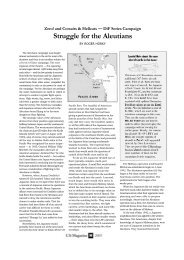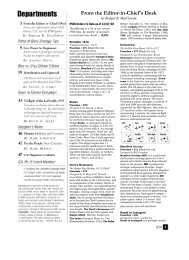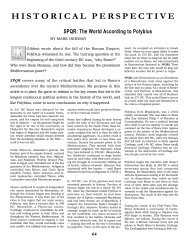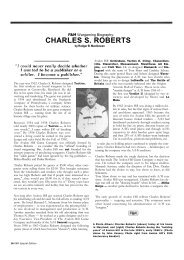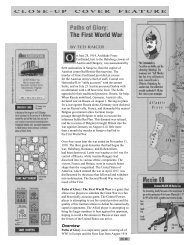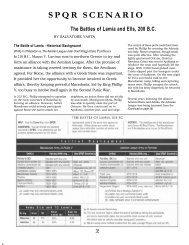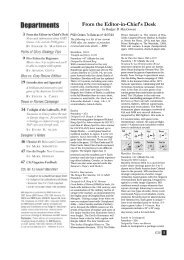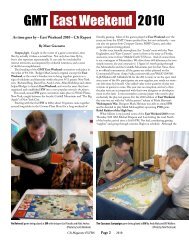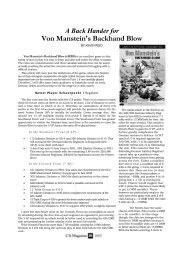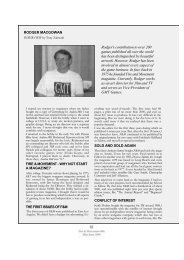New Air Variants for Britain Stands Alone - C3i Ops Center
New Air Variants for Britain Stands Alone - C3i Ops Center
New Air Variants for Britain Stands Alone - C3i Ops Center
Create successful ePaper yourself
Turn your PDF publications into a flip-book with our unique Google optimized e-Paper software.
D E S I G N E R ' S<br />
N O T E B O O K<br />
<strong>New</strong> <strong>Air</strong> <strong>Variants</strong> <strong>for</strong> <strong>Britain</strong> <strong>Stands</strong> <strong>Alone</strong><br />
BY JAMES P. WERBANETH<br />
There is still room <strong>for</strong> other "what ifs" in <strong>Britain</strong> <strong>Stands</strong> <strong>Alone</strong>, without<br />
stretching plausibility. Two variants, one <strong>for</strong> each side, can be added.<br />
<strong>Britain</strong> <strong>Stands</strong> <strong>Alone</strong> strides the line between history and<br />
alternate history. Some observers might define it as alternate<br />
history, as Operation Sealion was never executed and, as some<br />
point out, had no chance of succeeding if it were. Others go<br />
so far as to define the German plans as a great big bluff,<br />
calculated to frighten the British into coming to terms<br />
with the ascendent Reich.<br />
On the other hand, it is history. I<br />
believe wholeheartedly that Sealion<br />
was real, and that the preparations<br />
were made in earnest, with the goal of<br />
invading Great <strong>Britain</strong>. Two factors<br />
prevented it from being put into<br />
action. The first, and the most widely<br />
recognized, was the inability of the<br />
Luftwaffe to score a clear-cut victory in<br />
the Battle of <strong>Britain</strong>, gaining the air<br />
superiority needed to mount an<br />
amphibious operation. The other was<br />
that Adolf Hitler failed to order its<br />
commencement. With naval transports<br />
massed in occupied harbors, ground<br />
units earmarked and rein<strong>for</strong>ced <strong>for</strong><br />
cross-Channel invasion, and the most<br />
decisive air campaign in history<br />
mounted in the skies above, Operation<br />
Sealion was most certainly not the<br />
product of fevered imagination.<br />
There is one area in which the game<br />
really departs from history, and that is<br />
the variants. These all represent events<br />
that did not happen; the Norwegian<br />
campaign consumed fewer ships, the<br />
Germans developed amphibious<br />
techniques be<strong>for</strong>e the war, and <strong>Britain</strong><br />
receives more support from the Free<br />
French and the United States, <strong>for</strong><br />
example.<br />
There is still room <strong>for</strong> other "what ifs"<br />
in <strong>Britain</strong> <strong>Stands</strong> <strong>Alone</strong>, without stretching<br />
plausibility. Two variants, one <strong>for</strong><br />
each side, can be added to the mix of<br />
those already in the game. Further-<br />
more, players can put in a chit <strong>for</strong> no<br />
variant, adding the possibility that one<br />
side will draw fewer beneficial alternative<br />
events than the other.<br />
Ural Bomber<br />
The first chief of staff of the Luftwaffe,<br />
Walther Weyer, died in an air crash on<br />
3 June 1936. He was succeeded by<br />
Albert Kesselring.<br />
More than just a change in personnel,<br />
this amounted to a crucial change in<br />
philosophy <strong>for</strong> the nascent German air<br />
<strong>for</strong>ce. Weyer was dedicated to the<br />
concept of the Ural Bomber, a fourengine<br />
strategic bomber capable of<br />
hitting targets deep in the Soviet Union.<br />
His successor had a vision of a Luftwaffe<br />
concentrating on tactical airpower,<br />
which Kesselring saw as decisive in the<br />
sort of short and decisive campaigns of<br />
the coming blitzkrieg. By his reasoning,<br />
the Ural Bomber was conceived <strong>for</strong> a<br />
kind of war that Germany would not<br />
fight. In addition, Hermann Goring was<br />
impressed by the fact that three twoengine<br />
medium bombers could be<br />
produced <strong>for</strong> the same price as two<br />
four-engine machines.<br />
It was a decision that the Luftwaffe's<br />
Technical Office protested as shortsighted,<br />
and which historians have<br />
similarly condemned. Ironic in light of<br />
the Luftwaffe's almost pathological<br />
independence, the sort of tactical air<br />
<strong>for</strong>ce constructed by Goring and<br />
Kesselring proved ill-suited to<br />
independent operations in the Battle of<br />
<strong>Britain</strong>. Thus the failure of the<br />
Luftwaffe to secure the key precondition<br />
of Operation Sealion can be traced back<br />
to Wever's death and a strategic road<br />
not taken.<br />
There were two prototypes built to the<br />
Ural Bomber's specifications, the Dornier<br />
Do-19 and the Junkers Ju-89. Of the<br />
two, with identical payloads of 3,250<br />
pounds, the Junkers was definitely the<br />
more inspired, with better speed. In<br />
addition, there were severe problems in<br />
trying to fit defensive armament to the<br />
Do-19's airframe.<br />
There<strong>for</strong>e I feel that if a Ural Bomber had<br />
been adopted, it would have been the<br />
Ju-89. With this variant, players can<br />
experiment <strong>for</strong> themselves with the<br />
possibilities of long-range bombing<br />
against <strong>Britain</strong>. In fact, the German<br />
player can try various mixes of heavy<br />
and medium bombers, using the same<br />
cost ratio that influenced Goring's<br />
fateful decision.<br />
French Ai rpower<br />
<strong>Britain</strong> <strong>Stands</strong> <strong>Alone</strong> permits the<br />
inclusion of Free French ground troops,<br />
and the possibility that French naval<br />
units might have actively participated in<br />
the defense of United Kingdom.<br />
However, there are no French air units<br />
anywhere in the game.<br />
Yet it is no less possible that French<br />
airpower could have had a noticeable<br />
role. Historically, French pilots did fly<br />
with the Royal <strong>Air</strong> Force. Also, after the<br />
Germany victory over France in 1940,<br />
the RAF took possession of 227<br />
American-built Curtiss Hawk 75A<br />
fighters ordered by their late ally.<br />
Upgunned and brought up to British<br />
standards, most were sent to India,<br />
where they remained operational<br />
through 1943.
<strong>New</strong> <strong>Air</strong> <strong>Variants</strong> <strong>for</strong> <strong>Britain</strong> <strong>Stands</strong> <strong>Alone</strong><br />
The best fighter in the French inventory<br />
in 1940 was the Dewoitine D 520.<br />
Though somewhat less capable than the<br />
Spitfire, it was a highly regarded aircraft<br />
that became the backbone of the Vichy<br />
French air <strong>for</strong>ce.<br />
What if significant numbers of D 520<br />
pilots had flown to <strong>Britain</strong> instead of<br />
serving under the collaborationist<br />
Vichy regime? This question is the basis<br />
of the variant.<br />
Just as the Spitfire units in the standard<br />
countermix also represent the Hawker<br />
Hurricane, so the D 520 incorporates<br />
other types as well. Most obvious is the<br />
Hawk 75A, this time flown by the pilots<br />
<strong>for</strong> whom it was originally procured.<br />
Thus the counter's air-to-air strength is<br />
based primarily on my estimate of the<br />
D 520's abilities, but with the range<br />
more reflective of the lower endurance<br />
of the Curtiss fighter.<br />
<strong>Alone</strong> among all variants, this one has<br />
units and victory point values that differ<br />
between scenarios. The underlying<br />
rationale is that the French airpower in<br />
the British order of battle is the result of<br />
a one-time influx of machines and,<br />
above all, pilots. Their losses could not<br />
be made good by significant replacements,<br />
especially in terms of manpower.<br />
At the same time, a high rate of<br />
attrition during the summer of 1940<br />
would be certain.<br />
Thus there are half as many D 520<br />
points in the Operation Sealion scenario<br />
as there are in those <strong>for</strong> the July<br />
Invasion and the Battle of <strong>Britain</strong>. The<br />
victory point value <strong>for</strong> the September<br />
scenario are correspondingly lower, as<br />
half as much airpower is of half as<br />
valuable.<br />
No Variant<br />
Normally, when variants are randomly<br />
drawn, each side uses the same number<br />
of options. One new No Variant counter<br />
can be added to each player's pool to<br />
increase the uncertainty of the chit draw.<br />
With more possible combinations, there<br />
are more ways to play <strong>Britain</strong> <strong>Stands</strong><br />
<strong>Alone</strong>.<br />
Some players might find one side with a<br />
lucky draw will have a seemingly<br />
insurmountable edge. This can underline<br />
the factors that were important<br />
(and remain so) in amphibious warfare,<br />
without any artificial attempts at<br />
balance beyond the variants' victory<br />
point values.<br />
Besides, life is often unfair, and so<br />
is war.<br />
<strong>New</strong>Historical<strong>Variants</strong><br />
GERMAN<br />
8. Ural Bomber: The German player is<br />
eligible to build Ju-89 airpoints. Prior to<br />
setup, he removes He 111 and/or Ju 88<br />
airpoints in any quantity he wishes. For<br />
every three points removed, he receives<br />
two Ju-89 air points. If all airpoints of<br />
one type are removed, the German<br />
cannot receive replacement points <strong>for</strong><br />
that aircraft (on the grounds that it was<br />
never developed to the point of operational<br />
deployment). Ju-89 replacements<br />
can be received only on odd-numbered<br />
turns. VP -15<br />
BRITISH<br />
8. French <strong>Air</strong>power: In the Operation<br />
Sealion scenario, the British player<br />
receives three D 520 points, and in all<br />
others he receives six points. D 520<br />
strength and losses have no bearing on<br />
Spitfire losses or maximum allowable<br />
strength. Finally, there are no D 520<br />
replacements. VP +5 in Operation<br />
Sealion, +10 in other scenarios.<br />
SOURCES<br />
Green, William. Warplanes of the Third Reich.<br />
<strong>New</strong> York: Galahad, 1990.<br />
Taylor, John W.R. (ed.). Combat <strong>Air</strong>craft of the<br />
World. <strong>New</strong> York: Putnam's, 1969.



